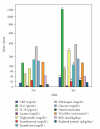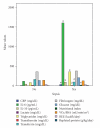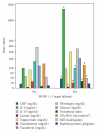Cytokines and metabolic patterns in pediatric patients with critical illness
- PMID: 20490277
- PMCID: PMC2871553
- DOI: 10.1155/2010/354047
Cytokines and metabolic patterns in pediatric patients with critical illness
Abstract
It is not known if cytokines, which are cell-derived mediators released during the host immune response to stress, affect metabolic response to stress during critical illness. The aim of this prospective study was to determine whether the metabolic response to stress is related to the inflammatory interleukin-6 (IL-6), 10 (IL-10), and other stress mediators' responses and to assess their relationships with different feeding patterns, nutritional markers, the severity of illness as assessed by the Multiple Organ System Failure (MOSF), the Pediatric Risk of Mortality Score (PRISM), systemic inflammatory response syndrome (SIRS), and mortality in critically ill children. Patients were classified as hypermetabolic, normometabolic, and hypometabolic when the measured resting energy expenditures (REE) were >110%, 90-110% and, <90% of the predicted basal metabolic rate, respectively. The initial predominance of the hypometabolic pattern (48.6%) declined within 1 week of acute stress (20%), and the hypermetabolic patterns dominated only after 2 weeks (60%). Only oxygen consumption (VO(2)) and carbon dioxide production (VCO(2)) (P < .0001) but none of the cytokines and nutritional markers, were independently associated with a hypometabolic pattern. REE correlated with the IL-10 but not PRISM. In the presence of SIRS or sepsis, CRP, IL-6, IL-10, Prognostic Inflammatory and Nutritional Index (NI), and triglycerides--but not glucose, VO(2), or VCO(2) increased significantly. High IL-10 levels (P = .0000) and low measured REE (P = .0000) were independently associated with mortality (11.7%), which was higher in the hypometabolic compared to other metabolic patterns (P < .005). Our results showed that only VO(2) and VCO(2), but not IL-6 or IL-10, were associated with a hypometabolic pattern which predominated the acute phase of stress, and was associated with increased mortality. Although in SIRS or sepsis, the cytokine response was reliably reflected by increases in NI and triglycerides, it was different from the metabolic (VO(2), VCO(2)) or glucose response.
Figures








References
-
- Kamimura MA, Draibe SA, Dalboni MA, et al. Serum and cellular interleukin-6 in haemodialysis patients: relationship with energy expenditure. Nephrology Dialysis Transplantation. 2007;22(3):839–844. - PubMed
-
- Proulx F, Joyal JS, Mariscalco MM, Leteurtre S, Leclerc F, Lacroix J. The pediatric multiple organ dysfunction syndrome. Pediatric Critical Care Medicine. 2009;10(1):12–22. - PubMed
-
- Cvijanovich NZ, King JC, Flori HR, Gildengorin G, Wong HR. Zinc homeostasis in pediatric critical illness. Pediatric Critical Care Medicine. 2009;10(1):29–34. - PubMed
-
- Hager P, Permert J, Wikström A-C, Herrington MK, Östenson C-G, Strömmer L. Preoperative glucocorticoid administration attenuates the systemic stress response and hyperglycemia after surgical trauma in the rat. Metabolism. 2009;58(4):449–455. - PubMed
-
- American College of Chest Physicians/Society of Critical Care Medicine Consensus Conference. Definitions for sepsis and organ failure and guidelines for the use of innovative therapies in sepsis. Critical Care Medicine. 1992;20:864–874. - PubMed
MeSH terms
Substances
LinkOut - more resources
Full Text Sources
Research Materials
Miscellaneous

